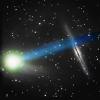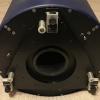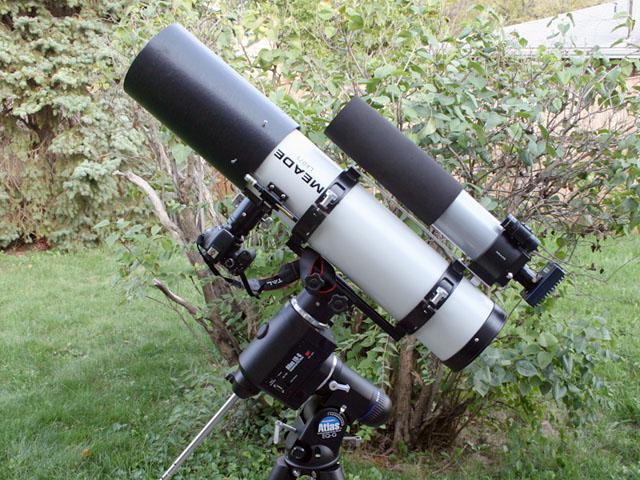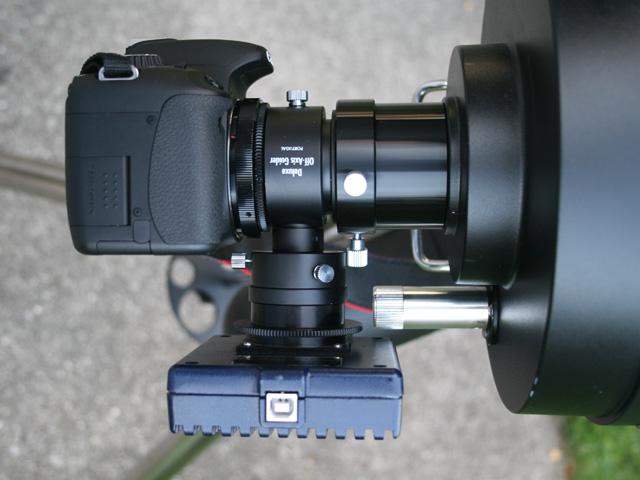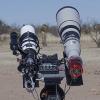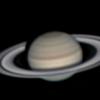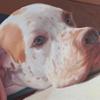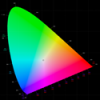
Guiding: OAG vs Guide Scope
#1

Posted 08 November 2012 - 01:08 PM
TIA
#2

Posted 08 November 2012 - 05:11 PM
1. limited FOV to find guide stars
2. Heavier equipment for the focuser to support.
3. Requires camera with two imaging chips or an attachment between the camera & focuser to divert the guide camera light. An attachment will increase back focus.
guide scope:
1. Can use different focal length and f/ ratio than imaging scope
2. Subject to differential flexure - imaging scope & guide scope bend (sag) a little differently.
3. Can be aimed at different stars.
4. 3. above can cause more field rotation because you can image further away from the guide star.
5. More weight for the mount to carry
An 80mm APO makes a great guide scope and, if it's a short focal length compared to your main scope, you can swap the imaging and guide scopes to get a wider FOV.
Phil
#3

Posted 08 November 2012 - 05:56 PM
#4

Posted 08 November 2012 - 06:40 PM
Be sure that your scope has enough in-focus travel to handle the extra length required by the OAG. I recently tried this on a scope of mine and found this problem.
#5

Posted 09 November 2012 - 03:46 AM
If it is then you have several options open to you including:"OAG" "On axis guiding".
#6

Posted 09 November 2012 - 04:27 AM
I used a guidescope for some time and almost always had problems
with differential flexure.So i ended up throwing away about 30% of the fits i got.
I recently changed to an OAG and i managed to get 15,20,30min subs without any trail.
However, it may be a bit tricky to focus the OAG at first.
You may check here:
http://www.cloudynig...5502330/page...
If you choose the guidescope path, make sure you mount it
very compactly with the main scope.
#7

Posted 09 November 2012 - 07:27 AM
What are the options?
#8

Posted 09 November 2012 - 09:15 AM
I think OAG's are the only way to go if you want tight, round stars above (approximately) 1,500mm focal length, despite the drawback of a limited field of view.
Oh, one other possible advantage to guide scopes is that you can guide on the center of the field. If you want to image a comet, this can be critical.
#9

Posted 09 November 2012 - 01:04 PM
#10

Posted 09 November 2012 - 06:28 PM
There are several off-axis guiders that can be used.Yes, that is the scope.
What are the options?
One example:
http://www.optcorp.c....aspx?pid=17671
You can also use an On-axis guider which makes finding a guidestar easy:
http://www.astromart...?article_id=836
#11

Posted 09 November 2012 - 06:44 PM
Phil forgot to mention that a OAG takes care of flexure, whereas a guide scope may cause flexure depending on the sturdiness of your gear.
Hope this helps,
Guylain
#12

Posted 10 November 2012 - 02:28 PM
#13

Posted 10 November 2012 - 03:33 PM
#14

Posted 11 November 2012 - 04:08 PM
#15

Posted 11 November 2012 - 05:02 PM
The longer the focal length you image at the more any flexure will show up.
#16

Posted 11 November 2012 - 05:19 PM
#17

Posted 26 December 2012 - 12:21 AM
Patrick
#18

Posted 26 December 2012 - 05:12 PM
With SCT mirror locks is the flexure issue as much of an issue with a side by side or guide scope arrangement? It seems like it would not be. I do not like off-axis guiders because I've been unable to get mine working to date.
Patrick
Flexure comes from more places then the mirror. I'm limited to 8m subs due to flexure in my setup despite the mirror locks.
I understand what you are saying about not getting an OAG working. I never got my Celestron Radial Guider working with my SSAG(Needed more inward focus). Then I tried the Older model Celestron OAG(Need more outward focus, but thumbscrew doesn't hold then camera stable enough)
I just purchased a TS9 OAG and will be getting a Lodestar. I'm fairly confident this setup will work, but won't know until it all shows up.
#19

Posted 27 December 2012 - 02:30 PM
#21

Posted 27 December 2012 - 06:53 PM
#22

Posted 27 December 2012 - 11:10 PM
Side-by-Side.. and an OAG with an AO!

#23

Posted 28 December 2012 - 07:28 PM
lately I experiment with 50mm mini guide scope and got same good guiding results as the tandem. http://www.flickr.co.../in/photostream
#24

Posted 28 December 2012 - 10:52 PM
Smeared stars due to mirror movement I don't consider to qualify as the term often defined (by that I mean purely mechanical issues elsewhere)- but it's an obvious reason to use an OAG.
Good rings and saddle plate/DTP are important, focusers and collets as well. OK, everthing is. Using two screws vs. one in ring attachment, making sure and certain all well seated and square to tube and there is no play if your rings have felt or other mat'l to avoid marring scope finish. I often state that IMO other than optics alone, it's a guality focuser assy that makes the difference, this includes the IMO often neglected collet type and being certain CCD is is 'ortho' or seated squarely/securely.
One thing I've been curious about that I see mentioned rarely and that is if you are remote and using a tripod (possibly allpies to porta-piers too)- that adds a world of things IMO as far as the tripod legs, load, tensioning, spreaders, surface type/hardness.
If you are going portable and setting up every time, there is lot to get right. I've been using a permanent setup (or somewhat permanent anyway) and can take my time - but I've had good stars all the way with various piggyback setups using refractors and being very careful about focuser CCD setup and critical focus.
Seems each setup has it's own things to be certain of, and this without considering the portable pier or tripod.
#25

Posted 28 December 2012 - 11:47 PM



